Geochemistry, U-Pb Zircon Ages and Hf Isotopes of Basement Rocks Beneath the Northeastern Margin of the Ordos Basin: Constraints on the Paleoproterozoic Evolution of the Western North China Craton
Abstract
:1. Introduction
2. Geological Background
3. Drill Hole and Samples
4. Analytical Techniques
4.1. CL Images
4.2. Zircon U-Pb Dating
4.3. Hf-Isotope Analysis
4.4. Major and Trace Element Analyses of Whole Rock
5. Analytical Results
5.1. Zircon U-Pb Geochronology
5.2. Zircon Hf Isotopes
5.3. Geochemical Characteristics
5.3.1. Major Elements Compositions
5.3.2. Trace Elements Compositions
6. Discussion
6.1. Protolith Age of the Basement Rocks from the Boreholes
6.2. Age of the Metamorphic Zircon
6.3. Nature of the Source Rocks
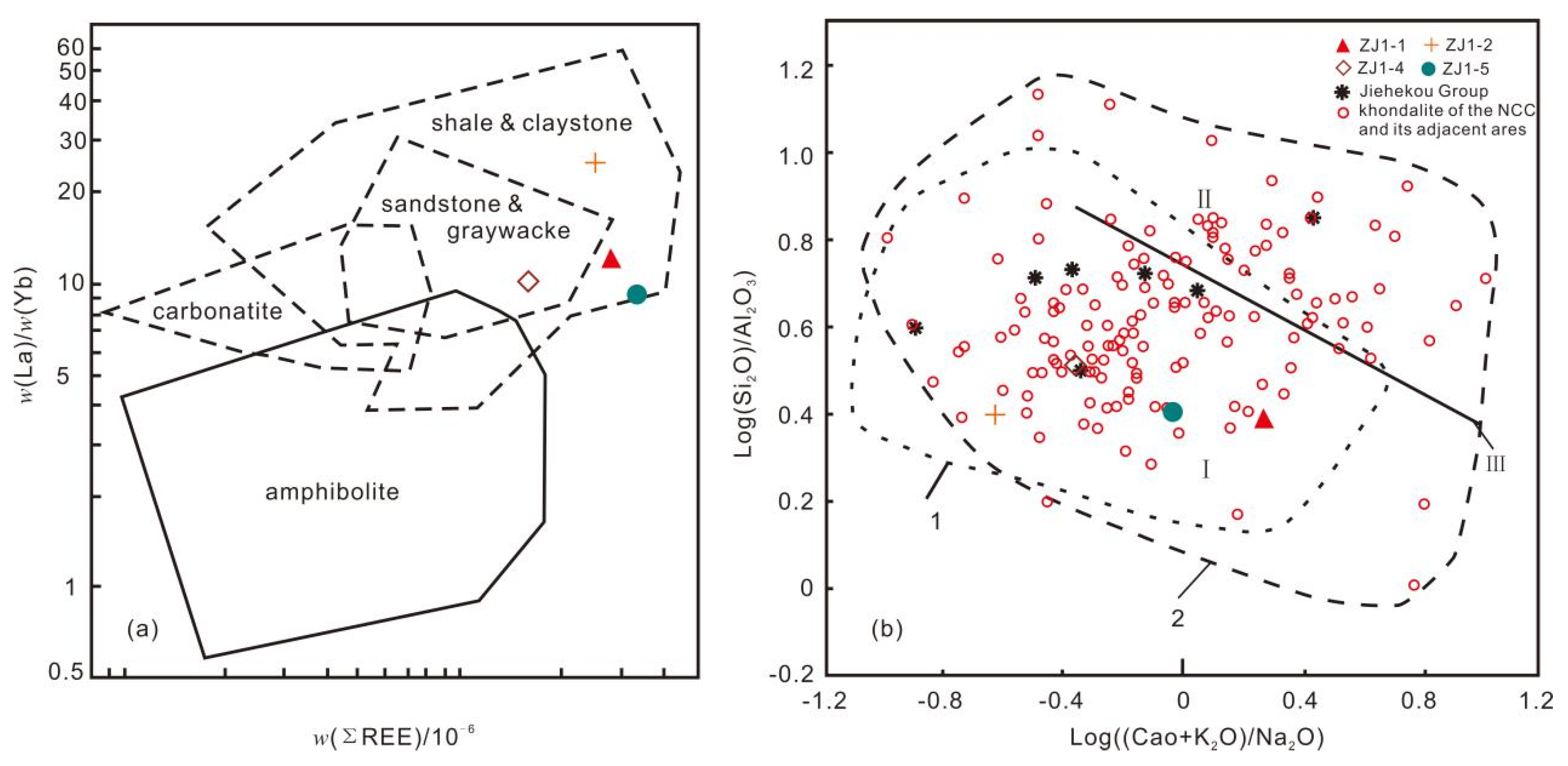
6.4. Geological Implication for the Paleoproterozoic Evolution of the Ordos Basin
7. Conclusions
Author Contributions
Funding
Acknowledgments
Conflicts of Interest
References
- Diwu, C.R.; Sun, Y.; Wilde, S.A.; Wang, H.L.; Dong, Z.C.; Zhang, H.; Wang, Q. New evidence for ~4.45 Ga terrestrial crust from zircon xenocrysts in Ordovician ignimbrite in the North Qinling Orogenic Belt, China. Gondwana Res. 2013, 23, 1484–1490. [Google Scholar] [CrossRef]
- Liu, D.Y.; Nutman, A.P.; Compston, W.; Wu, J.S.; Shen, Q.H. Remnants of ≥3800 Ma crust in the Chinese part of the Sino-Korean craton. Geology 1992, 20, 339–342. [Google Scholar] [CrossRef]
- Zhao, G.C.; Wilde, S.A.; Cawood, P.A.; Lu, L.Z. Thermal evolution of archean basement rocks from the eastern part of the North China Craton and its bearing on tectonic setting. Int. Geol. Rev. 1998, 40, 706–721. [Google Scholar] [CrossRef]
- Zhao, G.C.; Wilde, S.A.; Cawood, P.A.; Lu, L.Z. Thermal evolution of two textural types of mafic granulites in the North China craton: Evidence for both mantle plume and collisional tectonics. Geol. Mag. 1999, 136, 223–240. [Google Scholar] [CrossRef]
- Zhao, G.C.; Wilde, S.A.; Cawood, P.A.; Sun, M. Archean blocks and their boundaries in the North China Craton: Lithological, geochemical, structural and P-T path constraints and tectonic evolution. Precambrian Res. 2001, 107, 45–73. [Google Scholar] [CrossRef]
- Zhao, G.C.; Sun, M.; Wilde, S.A.; Li, S.Z. Late Archean to Paleoproterozoic evolution of the North China Craton: Key issues revisited. Precambrian Res. 2005, 136, 177–202. [Google Scholar] [CrossRef]
- Zhao, G.C.; Cawood, P.A.; Lu, L.Z. Petrology and P-T history of the Wutai amphibolites: Implications for tectonic evolution of the Wutai Complex, China. Precambrian Res. 1999, 93, 181–199. [Google Scholar] [CrossRef]
- Li, S.Z.; Zhao, G.C.; Sun, M.; Han, Z.Z.; Hao, D.; Luo, Y.; Xia, X.P. Deformation history of the Paleoproterozoic Liaohe Group in the Eastern Block of the North China Craton. J. Asian Earth Sci. 2005, 24, 659–674. [Google Scholar] [CrossRef]
- Li, S.Z.; Zhao, G.C.; Sun, M.; Luo, Y.; Han, Z.Z.; Zhao, G.T. Are the South and North Liaohe Groups different exotic terranes?—Nd isotope constraints on the Jiao-Liao-Ji orogen. Gondwana Res. 2006, 9, 198–208. [Google Scholar] [CrossRef]
- Li, S.Z.; Zhao, G.C. SHRIMP U–Pb zircon geochronology of the Liaoji Granitoids: Constraints on the evolution of the Paleoproterozoic Jiao-Liao-Ji belt in the eastern block of the North China craton. Precambrian Res. 2007, 158, 1–16. [Google Scholar] [CrossRef]
- Li, S.; Zhao, G.; Wilde, S.; Zhang, J.; Sun, M.; Zhang, G.; Dai, L. Deformation history of the Hengshan-Wutai-Fuping Complexes: Implications for the evolution of the Trans-North China Orogen. Gondwana Res. 2010, 18, 611–631. [Google Scholar] [CrossRef]
- Li, S.Z.; Zhao, G.C.; Santosh, M.; Liu, X.; Dai, L.M. Palaeoproterozoic Tectono-thermal Evolution and Deep Crustal Processes in the Jiao-Liao-Ji Belt, North China craton: A Review. Geol. J. 2011, 46, 525–543. [Google Scholar] [CrossRef]
- Li, S.; Zhao, G.; Santosh, M.; Liu, X.; Dai, L.; Suo, Y.; Tam, P.Y.; Song, M.; Wang, P. Paleoproterozoic structural evolution of the southern segment of the Jiao-Liao-Ji Belt, North China Craton. Precambrian Res. 2012, 200–203, 59–73. [Google Scholar] [CrossRef]
- Zhang, Q.S.; Yang, Z.S. Early Crust and Mineral Deposits of Liaodong Peninsula; Geological Publishing House: Beijing, China, 1988; pp. 1–574. (In Chinese) [Google Scholar]
- Santosh, M.; Sajeev, K.; Li, J.H. Extreme crustal metamorphism during Columbia supercontinent assembly: Evidence from North China Craton. Gondwana Res. 2006, 10, 256–266. [Google Scholar] [CrossRef]
- Santosh, M.; Tsunogae, T.; Li, J.H.; Liu, S.J. Discovery of sapphirine-bearing Mg-Al granulites in the North China Craton: Implications for Paleoproterozoic ultrahigh temperature metamorphism. Gondwana Res. 2007, 11, 263–285. [Google Scholar] [CrossRef]
- Santosh, M.; Wilde, S.A.; Li, J.H. Timing of Paleoproterozoic ultrahigh-temperature metamorphism in the North China Craton: Evidence from SHRIMP U–Pb zircon geochronology. Precambrian Res. 2007, 159, 178–196. [Google Scholar] [CrossRef]
- Santosh, M.; Zhao, D.P.; Kusky, T. Mantle dynamics of the Paleoproterozoic North China Craton: A perspective based on seismic tomography. J. Geodyn. 2010, 49, 39–53. [Google Scholar] [CrossRef]
- Wan, Y.S.; Song, B.; Liu, D.Y.; Wilde, S.A.; Wu, J.S.; Shi, Y.R.; Yin, X.Y.; Zhou, H.Y. SHRIMP U–Pb zircon geochronology of Palaeoproterozoic metasedimentary rocks in the North China Craton: Evidence for a major Late Palaeoproterozoic tectonothermal event. Precambrian Res. 2006, 149, 249–271. [Google Scholar] [CrossRef]
- Xia, X.P.; Sun, M.; Zhao, G.C.; Wu, F.Y.; Xu, P.; Zhang, J.H.; Luo, Y. U-Pb and Hf isotopic study of detrital zircons from the Wulashan khondalites: Constraints on the evolution of the Ordos Terrane, Western Block of the North China Craton. Earth Planet. Sci. Lett. 2006, 241, 581–593. [Google Scholar] [CrossRef] [Green Version]
- Xia, X.P.; Sun, M.; Zhao, G.C.; Luo, Y. LA-ICP-MS U-Pb geochronology of detrital zircons from the Jining Complex, North China Craton and its tectonic significance. Precambrian Res. 2006, 144, 199–212. [Google Scholar] [CrossRef] [Green Version]
- Wu, M.L.; Zhao, G.C.; Sun, M.; Yin, C.Q.; Li, S.Z.; Tam, Y. Petrology and P-T path of the Yishui mafic granulites: Implications for tectonothermal evolution of the Western Shandong Complex in the Eastern Block of the North China Craton. Precambrian Res. 2012, 222, 312–324. [Google Scholar] [CrossRef]
- Wu, M.L.; Zhao, G.C.; Sun, M.; Li, S.Z.; He, Y.H.; Bao, Z. Zircon U-Pb geochronology and Hf isotopes of major lithologies from the Yishui Terrane: Implications for the crustal evolution of the Eastern Block, North China Craton. Lithos 2013, 170, 164–178. [Google Scholar] [CrossRef]
- Wilde, S.A.; Zhao, G.C.; Sun, M. Development of the North China Craton During the Late Archaean and its Final Amalgamation at 1.8 Ga: Some Speculations on its Position Within a Global Palaeoproterozoic Supercontinent. Gondwana Res. 2002, 5, 85–94. [Google Scholar] [CrossRef]
- Zhao, G.C.; Sun, M.; Wilde, S.A.; Li, S.Z. A Paleo-Mesoproterozoic supercontinent: Assembly, growth and breakup. Earth Sci. Rev. 2004, 67, 91–123. [Google Scholar] [CrossRef] [Green Version]
- Kröner, A.; Wilde, S.A.; Li, J.H.; Wang, K.Y. Age and evolution of a late Archean to Paleoproterozoic upper to lower crustal section in the Wutaishan/Hengshan/Fuping terrain of northern China. J. Asian Earth Sci. 2005, 24, 577–595. [Google Scholar] [CrossRef]
- Hu, J.M.; Liu, X.S.; Li, Z.H.; Zhao, Y.; Zhang, S.H.; Liu, X.C.; Qu, H.J.; Chen, H. SHRIMP U-Pb zircon dating of the Ordos Basin basement and its tectonic significance. Chin. Sci. Bull. 2013, 58, 118–127. [Google Scholar] [CrossRef] [Green Version]
- Wan, Y.S.; Xie, H.Q.; Yang, H.; Wang, Z.J.; Liu, D.Y.; Kröner, A.; Wilde, S.A.; Geng, Y.S.; Sun, L.Y.; Ma, M.Z.; et al. Is the Ordos Block Archean or Paleoproterozoic in age? implications for the precambrian evolution of the North China Carton. Am. J. Sci. 2013, 313, 683–711. [Google Scholar] [CrossRef]
- Wang, W.; Liu, X.S.; Hu, J.M.; Li, Z.H.; Zhao, Y.; Zhai, M.G.; Liu, X.C.; Clarke, G.; Zhang, S.H.; Qu, H.J. Late Paleoproterozoic medium-P high grade metamorphism of basement rocks beneath the northern margin of the Ordos Basin, NW China: Petrology, phase equilibrium modelling and U–Pb geochronology. Precambrian Res. 2014, 251, 181–196. [Google Scholar] [CrossRef]
- Zhao, G.C.; Wilde, S.A.; Guo, J.H.; Cawood, P.A.; Sun, M.; Li, X.P. Single zircon grains record two paleoproterozoic collisional events in the north china craton. Precambrian Res. 2010, 177, 266–276. [Google Scholar] [CrossRef]
- Zhao, G.C.; Li, S.Z.; Zhang, J.; Sun, M.; Xia, X.P. A comment on “Tectonic evolution of the Hengshan–Wutai–Fuping complexes and its implication for the Trans-North China Orogen”. Precambrian Res. 2010, 176, 94–98. [Google Scholar] [CrossRef]
- Dong, C.Y.; Wan, Y.S.; Wilde, S.A.; Xu, Z.Y.; Ma, M.Z.; Xie, H.Q.; Liu, D.Y. Earliest Paleoproterozoic supracrustal rocks in the North China Craton recognized from the Daqingshan area of the Khondalite Belt: Constraints on craton evolution. Gondwana Res. 2014, 25, 1535–1553. [Google Scholar] [CrossRef]
- Yin, C.Q.; Zhao, G.C.; Sun, M.; Xia, X.P.; Wei, C.J.; Zhou, X.W.; Leung, W.H. LA-ICP-MS U–Pb zircon ages of the Qianlishan Complex: Constrains on the evolution of the Khondalite Belt in the Western Block of the North China Craton. Precambrian Res. 2009, 174, 78–94. [Google Scholar] [CrossRef]
- Zhou, X.W.; Geng, Y.S. Metamorphic age of the khondalites in the Helanshan region: Constraints on the evolution of the Western block in the North China Craton. Acta Petrol. Sin. 2009, 25, 1843–1852. [Google Scholar]
- Xia, X.P.; Sun, M.; Zhao, G.C.; Wu, F.Y.; Xie, L.W. U-Pb and Hf isotopic study of detrital zircons from the Lüliang khondalite, North China Craton, and their tectonic implications. Geol. Mag. 2009, 146, 701–716. [Google Scholar] [CrossRef]
- Liu, S.W.; Zhang, J.; Li, Q.G.; Zhang, L.F.; Wang, W.; Yang, P.T. Geochemistry and U–Pb zircon ages of metamorphic volcanic rocks of the Paleoproterozoic Lüliang Complex and constraints on the evolution of the Trans-North China Orogen, North China Craton. Precambrian Res. 2012, 222–223, 173–190. [Google Scholar] [CrossRef]
- Wan, Y.S.; Liu, D.Y.; Dong, C.Y.; Xu, Z.Y.; Wang, Z.J.; Wilde, S.A.; Yang, Y.; Liu, Z.H.; Zhou, H.Y. The Precambrian Khondalite Belt in the Daqingshan area, North China Craton: Evidence for multiple metamorphic events in the Palaeoproterozoic era. Geol. Soc. 2009, 323, 73–97. [Google Scholar] [CrossRef] [Green Version]
- Santosh, M.; Sajeev, K.; Li, J.H.; Liu, S.J.; Itaya, T. Counterclockwise exhumation of a hot orogen: The Paleoproterozoic ultrahigh-temperature granulites in the North China Craton. Lithos 2009, 110, 140–152. [Google Scholar] [CrossRef]
- Dong, C.Y.; Ma, M.Z.; Liu, S.J.; Xie, H.Q.; Liu, D.; Yi, L.; Wan, Y.S. Middle Paleoproterozoic crustal extensional regime in the North China Craton: New evidence from SHRIMP zircon U-Pb dating and whole-rock geochemistry of meta-gabbro in the Anshan-Gongchangling area. Acta Petrol. Sin. 2012, 28, 2785–2792. [Google Scholar]
- Dong, C.Y.; Liu, D.Y.; Li, J.J.; Wang, Y.S.; Zhou, H.Y.; Li, C.D.; Yang, Y.H.; Xie, L.W. Palaeoproterozoic Khondalite Belt in the western North China Craton: New evidence from SHRIMP dating and Hf isotope composition of zircons from metamorphic rocks in the Bayan Ul-Helan Mountains area. Chin. Sci. Bull. 2007, 52, 2984–2994. (In Chinese) [Google Scholar] [CrossRef]
- Williams, I.S. U–Th–Pb geochronology by ion microprobe. Rev. Econ. Geol. 1998, 1, 135. [Google Scholar]
- Nasdala, L.; Hofmeister, W.; Norberg, N.; Mattinson, J.M.; Corfu, F.; Dörr, W.; Kamo, S.L.; Kennedy, A.K.; Kronz, A.; Reiners, P.W.; et al. Zircon M257-a Homogeneous Natural Reference Material for the Ion Microprobe U-Pb Analysis of Zircon. Geostand. Geoanalytical Res. 2008, 32, 247–265. [Google Scholar] [CrossRef]
- Black, L.P.; Kamo, S.L.; Williams, I.S.; Mundil, R.; Davis, D.W.; Korsch, R.J.; Foudoulis, C. The application of SHRIMP to Phanerozoic geochronology; a critical appraisal of four zircon standards. Chem. Geol. 2003, 200, 171–188. [Google Scholar] [CrossRef]
- Ludwig, K.R. User’s manual for Isoplot 3.00: A geochronological toolkit for Microsoft Excel. Berkeley Geochronol. Cent. Spec. Publlication 2003, 4, 25–32. [Google Scholar]
- Cumming, G.L.; Richards, J.R. Ore lead isotope ratios in a continuously changing earth. Earth Planet. Sci. Lett. 1975, 28, 155–171. [Google Scholar] [CrossRef]
- Chu, N.C.; Taylor, R.N.; Chavagnac, V.; Nesbitt, R.W.; Boella, R.M.; Milton, J.A.; German, C.R.; Bayon, G.; Burton, K. Hf isotope ratio analysis using multi-collector inductively coupled plasma mass spectrometry:An evaluation of isobaric interference corrections. J. Anal. At. Spectrom. 2002, 17, 1567–1574. [Google Scholar] [CrossRef] [Green Version]
- Wu, F.Y.; Yang, Y.H.; Xie, L.W.; Yang, J.H.; Ping, X. Hf isotopic compositions of the standard zircons and baddeleyites used in U-Pb geochronology. Chem. Geol. 2006, 234, 105–126. [Google Scholar] [CrossRef]
- Albarède, F.; Scherer, E.E.; Blichert-Toft, J.; Rosing, M.; Simionovici, A.; Bizzarro, M. γ-ray irradiation in the early Solar System and the conundrum of the 176Lu decay constant. Geochim. Et Cosmochim. Acta 2006, 70, 1261–1270. [Google Scholar] [CrossRef]
- Blicherttoft, J.; Albarede, F. The Lu-Hf isotope geochemistry of chondrites and the evolution of the mantle-crust system. Earth Planet. Sci. Lett. 1997, 148, 243–258. [Google Scholar] [CrossRef]
- Griffin, W.L.; Pearson, N.J.; Belousova, E.; Jackson, S.E.; Van Achterbergh, E.; O’Reilly, S.Y.; Shee, S.R. The Hf isotope composition of cratonic mantle: LAM-MC-ICPMS analysis of zircon megacrysts in kimberlites. Geochim. Cosmochim. Acta. 2000, 64, 133–147. [Google Scholar] [CrossRef]
- Rudnick, R.L.; Gao, S.; Ling, W.L.; Liu, Y.S.; McDonough, W.F. Petrology and geochemistry of spinel peridotite xenoliths from Hannuoba and Qixia, North China craton. Lithos 2004, 77, 609–637. [Google Scholar] [CrossRef]
- Sun, S.S.; McDonough, W.F. Chemical and isotopic systematics of oceanic basalts: Implication for mantle composition and process. Geol. Soc. 1989, 42, 313–345. [Google Scholar] [CrossRef]
- Geng, Y.S.; Zhou, X.W.; Wang, X.S.; Ren, L.D. Late-Paleoproterozoic granite events and their geological significance in Helanshan area, Inner Mongolia: Evidence from geochronology. Acta Pet. Sin. 2009, 25, 1830–1842. [Google Scholar]
- Guo, J.H.; Zhai, M.G.; Xu, R.H. Timing of the granulite facies metamorphism in the Sanggan area, North China craton: Zircon U-Pb geochronology. Sci. China Ser. D Earth Sci. 2001, 44, 1010–1018. [Google Scholar] [CrossRef]
- Zhong, C.T.; Deng, J.F.; Wan, Y.S.; Mao, D.B.; Li, H.M. Magma recording of Paleoproterozoic orogeny in central segment of northern margin of North China Craton: Geochemical characteristics and zircon SHRIMP dating of S-type granitoids. Geochimica 2007, 36, 585–600. (In Chinese) [Google Scholar]
- Liu, S.W.; Zhao, G.C.; Wilde, S.A.; Shu, G.M.; Sun, M.; Li, Q.G.; Tian, W.; Zhang, J. Th–U–Pb monazite geochronology of the Lüliang and Wutai Complexes: Constraints on the tectonothermal evolution of the Trans-North China Orogen. Precambrian Res. 2006, 148, 205–224. [Google Scholar] [CrossRef]
- Liu, S.W.; Santosh, M.; Wang, W.; Bai, X.; Yang, P.T. Zircon U-Pb chronology of the Jianping Complex: Implications for the Precambrian crustal evolution history of the northern margin of North China Craton. Gondwana Res. 2011, 20, 48–63. [Google Scholar] [CrossRef]
- Dan, W.; Li, X.; Guo, J.; Liu, Y.; Wang, X. Integrated in situ zircon U–Pb age and Hf–O isotopes for the Helanshan khondalites in North China Craton: Juvenile crustal materials deposited in active or passive continental margin? Precambrian Res. 2012, 222–223, 143–158. [Google Scholar] [CrossRef]
- Yin, C.Q.; Zhao, G.C.; Guo, J.H.; Sun, M.; Xia, X.P.; Zhou, X.W.; Liu, C.H. U–Pb and Hf isotopic study of zircons of the Helanshan Complex: Constrains on the evolution of the Khondalite Belt in the Western Block of the North China Craton. Lithos 2011, 122, 25–38. [Google Scholar] [CrossRef]
- Li, J.H.; Zhai, M.G.; Li, Y.G.; Zhan, Y.G. Discovery of Late Archean high-pressure granulites in Luanping–Chengde area, Northern Hebei Province: Tectonic implications. Acta Petrol. Sin. 1998, 14, 34–41. [Google Scholar]
- Guo, J.H.; O’Brien, P.J.; Zhai, M.G. High-pressure granulites in the Sanggan area, North China craton: Metamorphic evolution, P–T paths and geotectonic significance. J. Metamorph. Geol. 2002, 20, 741–756. [Google Scholar] [CrossRef]
- Guo, J.H.; Sun, M.; Chen, F.K.; Zhai, M.G. Sm–Nd and SHRIMP U–Pb zircon geochronology of high-pressure granulites in the Sanggan area, North China Craton: Timing of Paleoproterozoic continental collision. J. Asian Earth Sci. 2005, 24, 629–642. [Google Scholar] [CrossRef]
- Kröner, A.; Wilde, S.A.; Zhao, G.C.; O’ Brien, P.J.; Sun, M.; Liu, D.Y.; Guo, J.H. Zircon geochronology and metamorphic evolution of mafic dykes in the Hengshan Complex of northern China: Evidence for late Palaeoproterozoic extension and subsequent high-pressure metamorphism in the North China Craton. Precambrian Res. 2006, 146, 45–67. [Google Scholar] [CrossRef]
- Liu, S.W.; Pan, Y.M.; Xie, Q.L.; Zhang, J.; Li, Q.G.; Yang, B. Geochemistry of the paleoproterozonic Nanying granitic gneisses in the Fuping complex: Implications for the tectonic evolution of the Central Zone, North China Craton. J. Asian Earth Sci. 2005, 24, 643–658. [Google Scholar] [CrossRef]
- Zhang, J.; Zhao, G.C.; Li, S.Z.; Sun, M.; Liu, S.W.; Wilde, S.A.; Kröner, A.; Yin, C.Q. Deformation history of the Hengshan Complex: Implications for the tectonic evolution of the Trans-North China Orogen. J. Struct. Geol. 2007, 29, 933–949. [Google Scholar] [CrossRef]
- Liu, S.W.; Li, Q.G.; Liu, C.H.; Lu, Y.J.; Zhang, F. Guandishan granitoids of the paleoproterozoic lüliang metamorphic complex in the trans-north china orogen:shrimp zircon ages, petrogenesis and tectonic implications. Acta Geol. Sin.-Engl. Ed. 2009, 93, 158–180. [Google Scholar]
- Liu, S.W.; Yang, P.T.; Wang, Z.Q.; Luo, P.; Wang, Y.Q.; Luo, G.H. LA-ICPMS zircon U-Pb ages and geochemistry of Neoproterozoic low-grade metavolcanic rocks in Wuyuan-Dexing area of northeastern Jianxi Province. Acta Petrol. Sin. 2013, 29, 581–593. (In Chinese) [Google Scholar]
- Wan, Y.S.; Geng, Y.S.; Shen, Q.H.; Zhang, R.X. Khondalite series-geochronology and geochemistry of the Jiehekou Group in Luliang area. Acta Petrol. Sin. 2000, 16, 49–58. (In Chinese) [Google Scholar]
- Zhao, G.C.; Wilde, S.A.; Sun, M.; Li, S.Z.; Li, X.P.; Zhang, J. SHRIMP U–Pb zircon ages of granitoid rocks in the Luliang Complex: Implications for the accretion and evolution of the Trans-North China Orogen. Precambrian Res. 2008, 160, 213–226. [Google Scholar] [CrossRef]
- Xiao, L.L.; Wang, G.D. Zircon U–Pb dating of metabasic rocks in the Zanhuang metamorphic complex and its geological significance. Acta Petrol. Miner. 2011, 30, 781–794. [Google Scholar]
- Xiao, L.L.; Wu, C.M.; Zhao, G.C.; Guo, J.H.; Ren, L.D. Metamorphic P–T paths of the Zanhuang amphibolites and metapelites: Constraints on the tectonic evolution of the Paleoproterozoic Trans-North China Orogen. Int. J. Earth Sci. 2011, 100, 717–739. [Google Scholar] [CrossRef]
- Condie, K.C.; Boryta, M.D.; Liu, J.Z.; Qian, X.L. The origin of khondalites: Geochemical evidence from the Archean to Early Proterozoic granulite belt in the North China craton. Precambrian Res. 1992, 59, 207–223. [Google Scholar] [CrossRef]
- Geng, Y.S.; Wan, Y.S.; Shen, Q.H.; Li, H.M.; Zhang, R.X. Chronological framework of the early Precambrian important events in the Luliang area, Shanxi Province. Acta Pet. Sin. 2000, 74, 223–231. (In Chinese) [Google Scholar]
- Geng, Y.S.; Yang, C.H.; Wan, Y.S. Paleoproterozoic granitic magmatism in the Lüliang area. North China Craton: Constraint from isotopic geochronology. Acta Petrol. Sin. 2006, 22, 305–314. (In Chinese) [Google Scholar]
- Zhao, G.C.; Wilde, S.A.; Cawood, P.A.; Sun, M. SHRIMP U-Pb zircon ages of the Fuping Complex: Implications for Late Archean to Paleoproterozoic accretion and assembly of the North China Craton. Am. J. Sci. 2002, 302, 191–226. [Google Scholar] [CrossRef]
- Guan, H.; Sun, M.; Wilde, S.A.; Zhou, X.; Zhai, M. SHRIMP U–Pb zircon geochronology of the Fuping Complex: Implications for formation and assembly of the North China Craton. Precambrian Res. 2002, 113, 1–18. [Google Scholar] [CrossRef]
- Wilde, S.A.; Cawood, P.A.; Wang, K.; Nemchin, A.A. Granitoid evolution in the Late Archean Wutai Complex, North China Craton. J. Asian Earth Sci. 2005, 24, 597–613. [Google Scholar] [CrossRef]
- Li, L.; Zeng, Z.; Lu, Y.; Wei, Y.; Xiang, S.; Pan, L. LA-ICP-MS U–Pb geochronology of detrital zircons from the Zhaochigou Formation-complex in the Helan Mountain and its tectonic significance. Chin. Sci. Bull. 2014, 59, 1425–1437. [Google Scholar] [CrossRef]
- Zhao, G.C.; Cawood, P.A. Precambrian Geology of China. Precambrian Res. 2012, 222–223, 13–54. [Google Scholar] [CrossRef]
- Bhatia, M.R. Rare earth element geochemistry of Australian Paleozoic graywackes and mudrocks: Provenance and tectonic control. Sediment. Geol. 1985, 45, 97–113. [Google Scholar] [CrossRef]
- Dash, B.; Sahu, K.N.; Bowes, D.R. Geochemistry and original nature of Precambrian khondalites in the Eastern Ghats, Orissa, India. Trans. R. Soc. Edinb. Earth Sci. 1987, 78, 115–127. [Google Scholar] [CrossRef]
- Bhatia, M.R.; Crook, K.A.W. Trace element characteristics of graywackes and tectonic setting discrimination of sedimentary basins. Comtrib. Miner. Petrol. 1986, 92, 181–193. [Google Scholar] [CrossRef]
- Zhang, H.F.; Yang, Y.H.; Santosh, M.; Zhao, X.M.; Ying, J.F.; Xiao, Y. Evolution of the Archean and Paleoproterozoic lower crust beneath the Trans-North China Orogen and the Western Block of the North China Craton. Gondwana Res. 2012, 22, 73–85. [Google Scholar] [CrossRef]
- Geng, Y.S.; Du, L.L.; Ren, L.D. Growth and reworking of the early Precambrian continental crust in the North China Craton: Constraints from zircon Hf isotopes. Gondwana Res. 2012, 21, 517–529. [Google Scholar] [CrossRef]
- Du, L.L.; Yang, C.H.; Wang, W.; Ren, L.D.; Wan, Y.S.; Song, H.X.; Gao, L.Z.; Geng, Y.S.; Hou, K.J. Sijizhuang formation conglomerate. Sci. China Earth Sci. 2012, 55, 1796–1814. [Google Scholar] [CrossRef]
- Du, L.L.; Yang, C.H.; Wang, W.; Ren, L.D.; Wan, Y.S.; Song, H.X.; Gao, L.Z.; Geng, Y.S.; Hou, K.J. Provenance of the Paleoproterozoic Hutuo Group basal conglomerates and Neoarchean crustal growth in the Wutai Mountains, North China Craton: Evidence from granite and quartzite pebble zircon U-Pb ages and Hf isotopes. Sci. China Earth Sci. 2012, 55, 19. [Google Scholar] [CrossRef]
- Wan, Y.S.; Liu, D.Y.; Wang, W.; Song, T.R.; Kröner, A.; Dong, C.Y.; Zhou, H.Y.; Yin, X.Y. Provenance of Meso- to Neoproterozoic cover sediments at the Ming Tombs, Beijing, North China Craton: An integrated study of U–Pb dating and Hf isotopic measurement of detrital zircons and whole-rock geochemistry. Gondwana Res. 2011, 20, 219–242. [Google Scholar] [CrossRef]

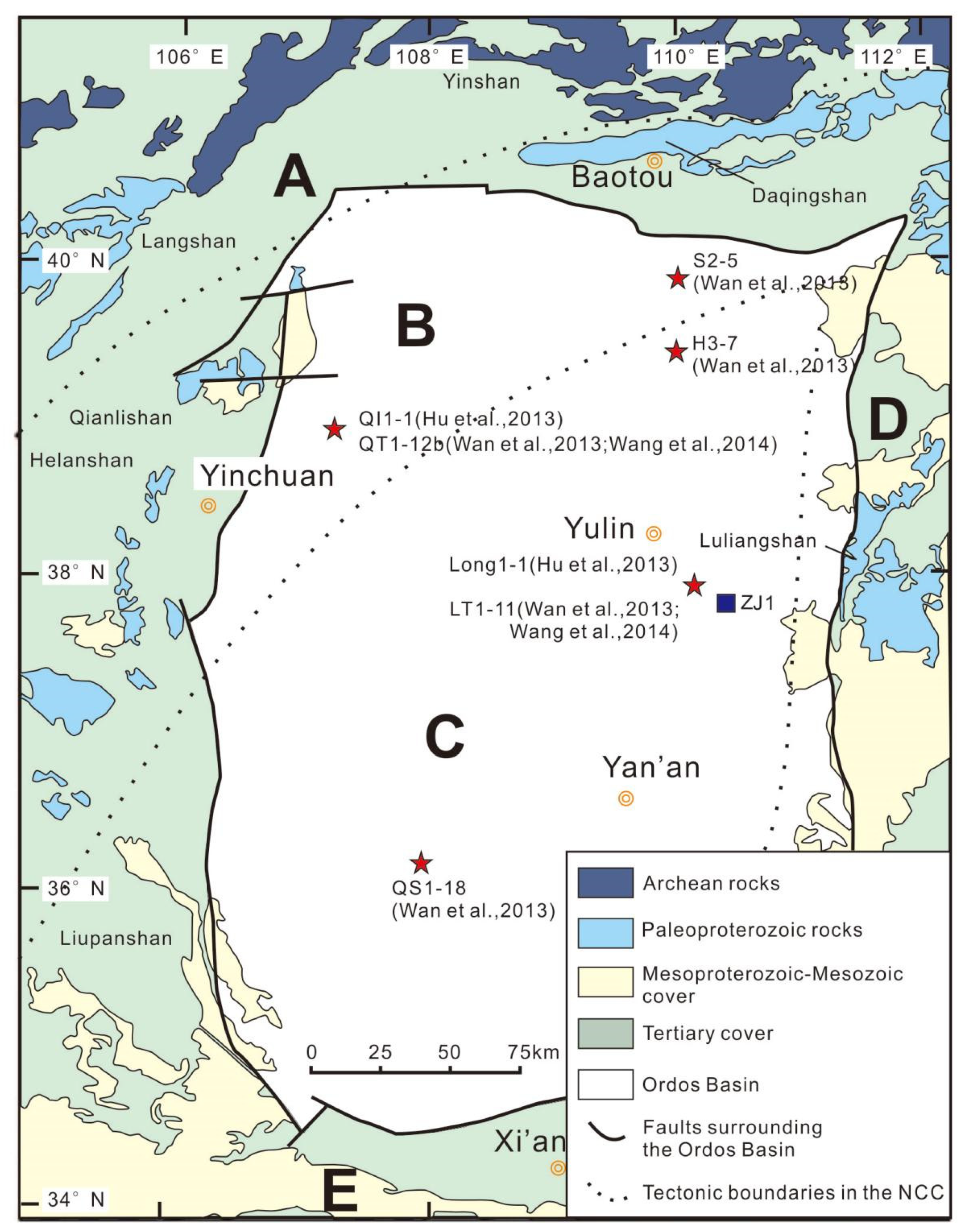
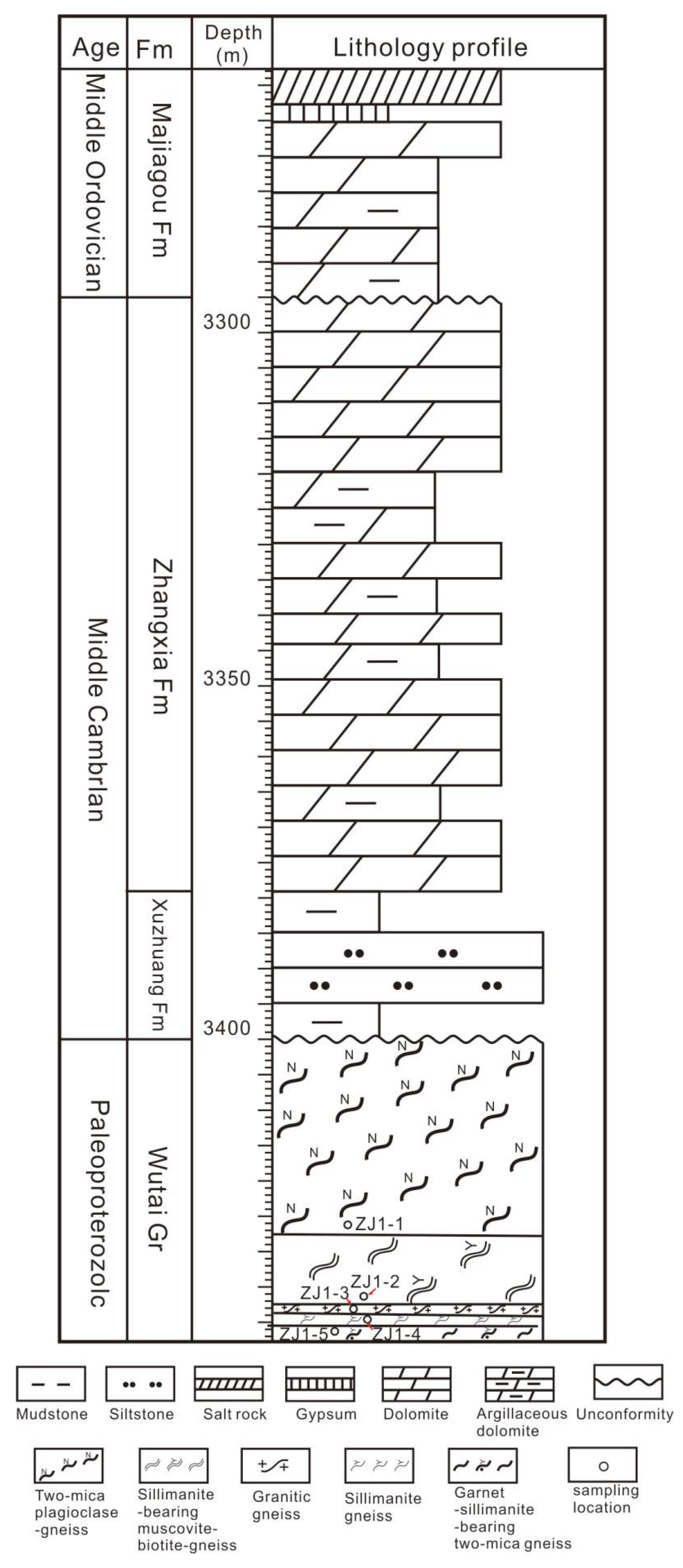

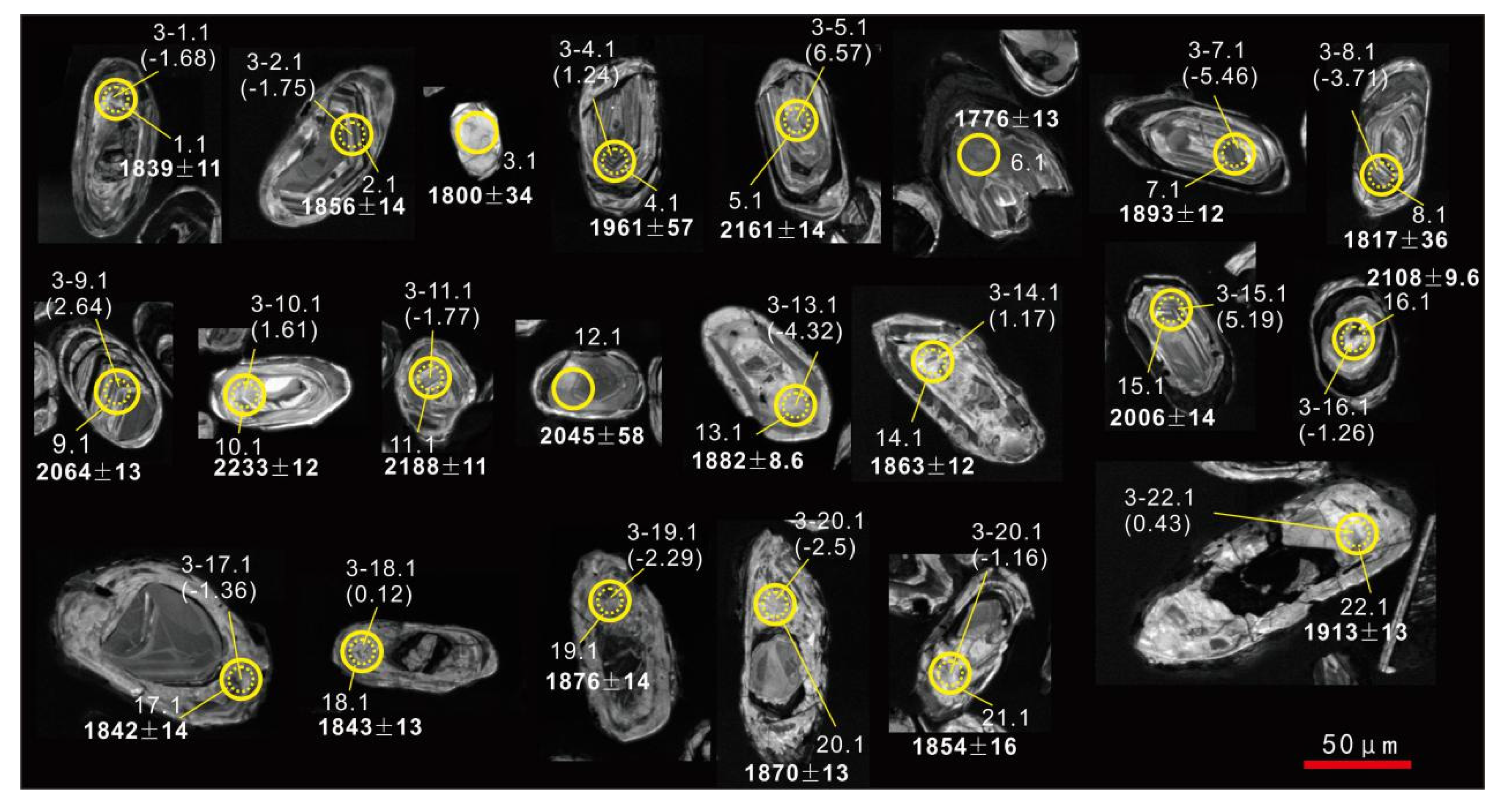

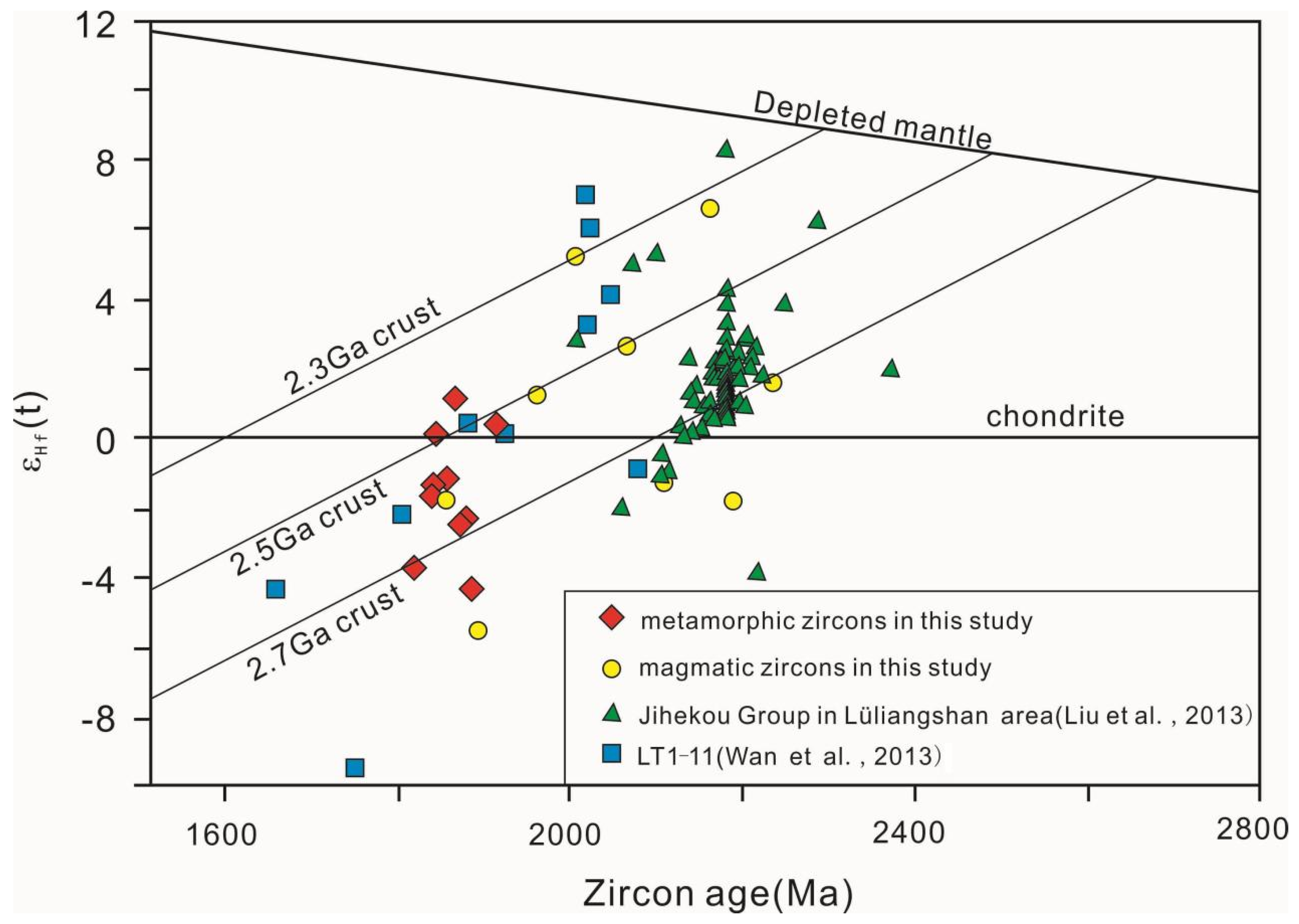

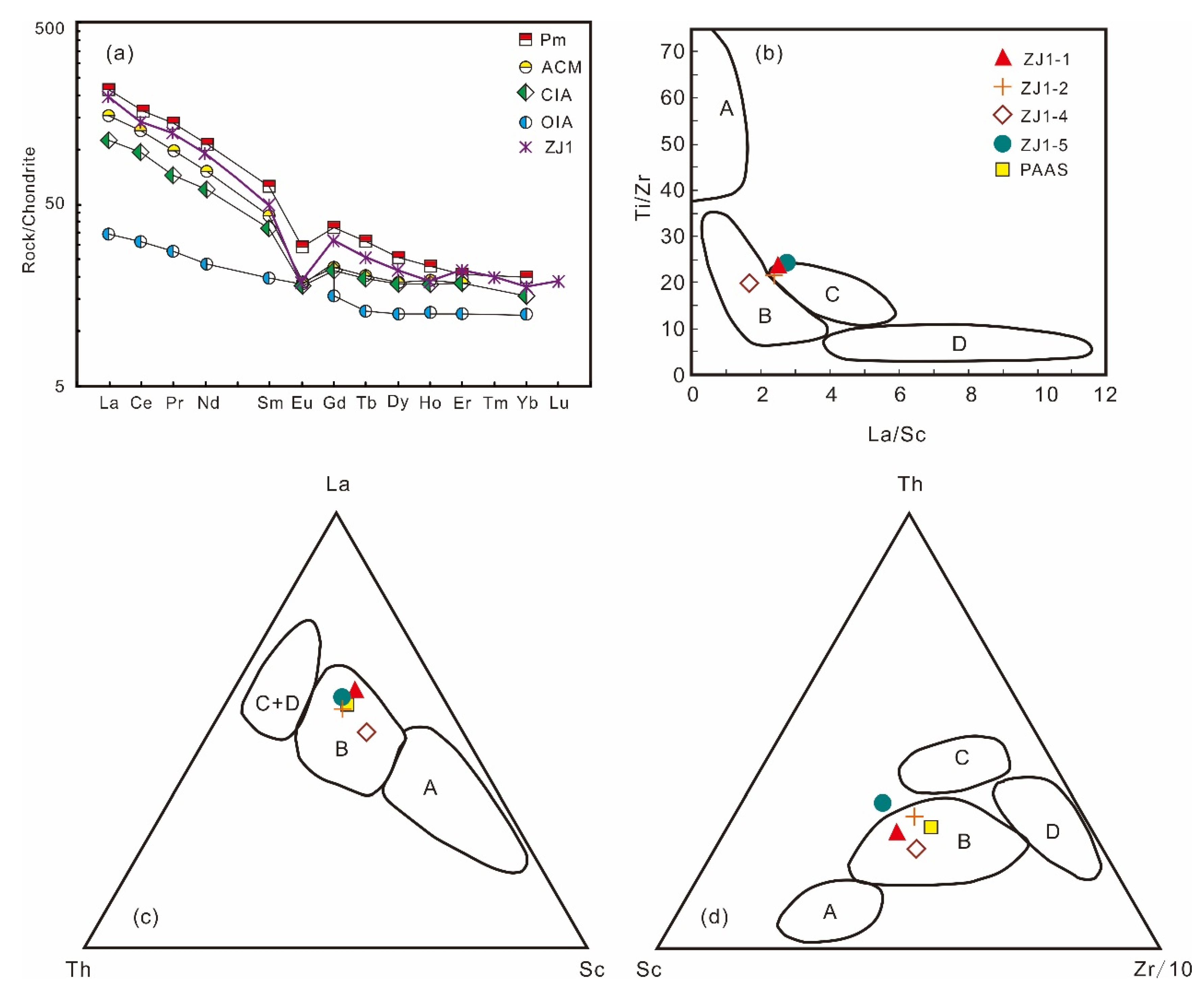
| Spot | 206Pbc (Weight-%) | U (Weight-ppm) | Th (Weight-ppm) | 232Th/238U | 206Pb* (Weight- ppm) | 206Pb/238U Age (Ma) | 207Pb/206Pb Age (Ma) | 208Pb/232Th Age (Ma) | 207Pb/206Pb* | ±% | 207Pb*/235U | ±% | 206Pb*/238U | ±% | Err corr | Discordant (%) | |||
|---|---|---|---|---|---|---|---|---|---|---|---|---|---|---|---|---|---|---|---|
| 1.1R | 0.34 | 848.12 | 76.85 | 0.09 | 146 | 1171 | ±8.3 | 1839 | ±11 | 1.201 | ±59 | 0.11245 | 0.610 | 3.09 | 0.99 | 0.20 | 0.78 | 0.84 | 36.35 |
| 2.1C | 0.55 | 471.30 | 107.09 | 0.23 | 79.8 | 1153 | ± 8.7 | 1856 | ±14 | 1251 | ±34 | 0.11346 | 0.790 | 3.07 | 1.10 | 0.20 | 0.82 | 0.80 | 37.85 |
| 3.1R | 0.81 | 264.22 | 2.70 | 0.01 | 34.4 | 904 | ± 8.6 | 1800 | ±34 | 3630 | ±1200 | 0.11000 | 1.900 | 2.28 | 2.10 | 0.15 | 1.00 | 0.65 | 49.79 |
| 4.1C | 1.98 | 466.14 | 266.92 | 0.59 | 92.6 | 1317 | ±11 | 1961 | ±57 | 1421 | ±68 | 0.12030 | 3.200 | 3.76 | 3.30 | 0.23 | 0.89 | 0.35 | 32.84 |
| 5.1C | 0.44 | 301.37 | 79.82 | 0.27 | 79.1 | 1713 | ±14 | 2161 | ±14 | 1743 | ±61 | 0.13470 | 0.780 | 5.65 | 1.20 | 0.30 | 0.94 | 0.83 | 20.74 |
| 6.1R | 0.37 | 458.37 | 35.96 | 0.08 | 86.5 | 1276 | ± 9.5 | 1776 | ±13 | 1606 | ±82 | 0.10861 | 0.720 | 3.28 | 1.10 | 0.22 | 0.82 | 0.81 | 28.19 |
| 7.1C | 0.38 | 525.11 | 117.37 | 0.23 | 94.8 | 1226 | ± 8.7 | 1893 | ±12 | 1438 | ±30 | 0.11587 | 0.680 | 3.35 | 1.00 | 0.21 | 0.78 | 0.81 | 35.26 |
| 8.1R | 4.07 | 865.76 | 71.57 | 0.09 | 137 | 1049 | ± 7.7 | 1817 | ±36 | 1170 | ±370 | 0.11110 | 2.000 | 2.71 | 2.10 | 0.18 | 0.79 | 0.73 | 42.28 |
| 9.1C | 0.14 | 415.07 | 125.94 | 0.31 | 92.3 | 1482 | ±11 | 2064 | ±13 | 1874 | ±26 | 0.12750 | 0.720 | 4.54 | 1.10 | 0.26 | 0.83 | 0.74 | 28.21 |
| 10.1R | 1.31 | 1144.79 | 45.80 | 0.04 | 304 | 1715 | ±11 | 2233 | ±12 | 1943 | ±430 | 0.14046 | 0.670 | 5.90 | 1.00 | 0.30 | 0.76 | 0.89 | 23.21 |
| 11.1C | 0.48 | 294.33 | 89.43 | 0.31 | 88.2 | 1920 | ±14 | 2188 | ±11 | 2361 | ±43 | 0.13687 | 0.640 | 6.55 | 1.00 | 0.35 | 0.83 | 0.83 | 12.23 |
| 12.1C | 1.34 | 306.12 | 64.87 | 0.22 | 84.2 | 1770 | ±15 | 2045 | ±58 | 2609 | ±290 | 0.12610 | 3.300 | 5.50 | 3.40 | 0.32 | 0.96 | 0.33 | 13.40 |
| 13.1R | 0.27 | 1666.28 | 30.11 | 0.02 | 294 | 1201 | ± 7.9 | 1882 | ±8.6 | 1641 | ±190 | 0.11514 | 0.480 | 3.25 | 0.86 | 0.20 | 0.72 | 0.86 | 36.17 |
| 14.1R | 0.21 | 526.20 | 10.82 | 0.02 | 112 | 1422 | ±10 | 1863 | ±12 | 1797 | ±250 | 0.11393 | 0.660 | 3.88 | 1.00 | 0.25 | 0.81 | 0.82 | 23.65 |
| 15.1C | 0.35 | 296.42 | 75.45 | 0.26 | 66.3 | 1488 | ±12 | 2006 | ±14 | 1697 | ±37 | 0.12338 | 0.800 | 4.42 | 1.20 | 0.26 | 0.87 | 0.78 | 25.83 |
| 16.1C | 0.34 | 592.32 | 58.53 | 0.10 | 142 | 1585 | ±11 | 2108 | ±9.6 | 1980 | ±67 | 0.13072 | 0.540 | 5.03 | 0.96 | 0.28 | 0.79 | 0.86 | 24.78 |
| 17.1R | 0.62 | 561.33 | 55.59 | 0.10 | 92.4 | 1124 | ± 8.2 | 1842 | ±14 | 449 | ±75 | 0.11263 | 0.780 | 2.96 | 1.10 | 0.19 | 0.79 | 0.84 | 38.98 |
| 18.1R | 0.67 | 669.15 | 11.52 | 0.02 | 140 | 1401 | ±10.0 | 1843 | ±13 | 1784 | ± 510 | 0.11266 | 0.730 | 3.77 | 1.10 | 0.24 | 0.79 | 0.84 | 23.97 |
| 19.1R | 0.57 | 506.15 | 9.92 | 0.02 | 110 | 1450 | ±11 | 1876 | ±14 | 1319 | ±470 | 0.11474 | 0.780 | 3.99 | 1.10 | 0.25 | 0.81 | 0.83 | 22.72 |
| 20.1R | 0.62 | 484.47 | 6.25 | 0.01 | 105 | 1446 | ±10 | 1870 | ±13 | 1609 | ±680 | 0.11437 | 0.730 | 3.97 | 1.10 | 0.25 | 0.80 | 0.84 | 22.67 |
| 21.1R | 0.89 | 561.05 | 36.60 | 0.07 | 126 | 1483 | ±11 | 1854 | ±16 | 605 | ±200 | 0.11330 | 0.910 | 4.04 | 1.20 | 0.26 | 0.85 | 0.84 | 19.97 |
| 22.1R | 0.53 | 542.84 | 10.23 | 0.02 | 114 | 1401 | ±10 | 1913 | ±13 | 2071 | ±440 | 0.11711 | 0.740 | 3.92 | 1.10 | 0.24 | 0.80 | 0.83 | 26.75 |
| Age Spot | Hf Spot | Age (Ma) | 176Yb 177Hf | 176Lu 177Hf | 2σ | 176Hf 177Hf | 2σ | εHf(0) | εHf(t) | TDM | TDMc | fLu/Hf |
|---|---|---|---|---|---|---|---|---|---|---|---|---|
| 1.1 | 3-1.1 | 1839 | 0.013333 | 0.000494 | 0.0000196 | 0.281583 | 0.0000406 | −42.06 | −1.68 | 2306 | 2596 | −0.99 |
| 2.1 | 3-2.1 | 1856 | 0.032978 | 0.001220 | 0.0000068 | 0.281595 | 0.0000334 | −41.61 | −1.75 | 2332 | 2612 | −0.96 |
| 4.1 | 3-4.1 | 1961 | 0.006096 | 0.000320 | 0.0000020 | 0.281581 | 0.0000311 | −42.12 | 1.24 | 2298 | 2509 | −0.99 |
| 5.1 | 3-5.1 | 2161 | 0.025171 | 0.000988 | 0.0000073 | 0.281630 | 0.0000299 | −40.37 | 6.57 | 2270 | 2335 | −0.97 |
| 7.1 | 3-7.1 | 1893 | 0.018373 | 0.000703 | 0.0000058 | 0.281450 | 0.0000212 | −46.76 | −5.46 | 2499 | 2869 | −0.98 |
| 8.1 | 3-8.1 | 1817 | 0.025503 | 0.000957 | 0.0000120 | 0.281555 | 0.0000301 | −43.04 | −3.71 | 2372 | 2705 | −0.97 |
| 9.1 | 3-9.1 | 2064 | 0.035497 | 0.001294 | 0.0000108 | 0.281593 | 0.0000287 | −41.71 | 2.64 | 2340 | 2502 | −0.96 |
| 10.1 | 3-10.1 | 2233 | 0.022739 | 0.000970 | 0.0000053 | 0.281445 | 0.0000290 | −46.94 | 1.61 | 2523 | 2697 | −0.97 |
| 11.1 | 3-11.1 | 2188 | 0.020053 | 0.000797 | 0.0000082 | 0.281371 | 0.0000273 | −49.54 | −1.77 | 2612 | 2869 | −0.98 |
| 13.1 | 3-13.1 | 1882.1 | 0.014843 | 0.000539 | 0.0000073 | 0.281483 | 0.0000255 | −45.6 | −4.32 | 2444 | 2791 | −0.98 |
| 14.1 | 3-14.1 | 1863 | 0.020868 | 0.000783 | 0.0000248 | 0.281658 | 0.0000201 | −39.4 | 1.17 | 2220 | 2437 | −0.98 |
| 15.1 | 3-15.1 | 2006 | 0.033023 | 0.001217 | 0.0000127 | 0.281698 | 0.0000190 | −38 | 5.19 | 2191 | 2300 | −0.96 |
| 16.1 | 3-16.1 | 2107.60 | 0.012961 | 0.000463 | 0.0000058 | 0.281422 | 0.0000225 | −47.74 | −1.26 | 2520 | 2776 | −0.99 |
| 17.1 | 3-17.1 | 1842 | 0.015034 | 0.000629 | 0.0000188 | 0.281594 | 0.0000165 | −41.66 | −1.36 | 2298 | 2578 | −0.98 |
| 18.1 | 3-18.1 | 1843 | 0.028107 | 0.001092 | 0.0000116 | 0.281651 | 0.0000231 | −39.64 | 0.12 | 2248 | 2489 | −0.97 |
| 19.1 | 3-19.1 | 1876 | 0.025430 | 0.000982 | 0.0000146 | 0.281559 | 0.0000171 | −42.9 | −2.29 | 2368 | 2663 | −0.97 |
| 20.1 | 3-20.1 | 1870 | 0.016556 | 0.000630 | 0.0000052 | 0.281545 | 0.0000141 | −43.4 | −2.5 | 2365 | 2669 | −0.98 |
| 21.1 | 3-21.1 | 1854 | 0.035072 | 0.001356 | 0.0000253 | 0.281618 | 0.0000186 | −40.81 | −1.16 | 2309 | 2574 | −0.96 |
| 22.1 | 3-22.1 | 1913 | 0.040506 | 0.001503 | 0.0000530 | 0.281632 | 0.0000150 | −40.33 | 0.43 | 2299 | 2522 | −0.95 |
| Sample No. | ZJ1-1 | ZJ1-2 | ZJ1-3 | ZJ1-4 | ZJ1-5 | Sample No. | ZJ1-1 | ZJ1-2 | ZJ1-3 | ZJ1-4 | ZJ1-5 |
|---|---|---|---|---|---|---|---|---|---|---|---|
| SiO2 | 52.2 | 55.0 | 58.3 | 61.8 | 55.6 | Th | 17.8 | 21 | 4.75 | 13.1 | 24.7 |
| TiO2 | 0.9 | 0.9 | 1.0 | 0.8 | 0.7 | U | 2.38 | 3.2 | 1.63 | 2.55 | 4.82 |
| Al2O3 | 21.5 | 21.3 | 13.2 | 18.7 | 21.1 | La | 64.3 | 54.5 | 8.77 | 34.1 | 71.1 |
| Fe2O3 | 1.7 | 1.5 | 1.2 | 1.4 | 1.3 | Ce | 113 | 105 | 17.8 | 64.3 | 134 |
| FeO | 7.4 | 6.0 | 10.2 | 5.6 | 6.5 | Pr | 15.7 | 14.3 | 2.51 | 8.46 | 18.1 |
| MnO | 0.1 | 0.1 | 0.1 | 0.1 | 0.1 | Nd | 57.8 | 54.5 | 10.3 | 32.3 | 68.4 |
| MgO | 3.6 | 2.9 | 6.5 | 2.5 | 2.7 | Sm | 9.04 | 9.46 | 2.44 | 5.27 | 12 |
| CaO | 2.2 | 1.0 | 1.1 | 0.5 | 1.1 | Eu | 1.59 | 0.75 | 0.41 | 1.05 | 1.59 |
| Na2O | 3.4 | 0.4 | 1.0 | 1.4 | 2.9 | Gd | 7.3 | 7.43 | 3.15 | 4.71 | 9.91 |
| K2O | 3.1 | 6.1 | 2.7 | 4.5 | 4.5 | Tb | 1.08 | 0.88 | 0.6 | 0.69 | 1.52 |
| P2O5 | 0.1 | 0.0 | 0.1 | 0.1 | 0.1 | Dy | 6.2 | 4.05 | 3.89 | 4.15 | 9.32 |
| H2O+ | 3.3 | 3.7 | 3.8 | 2.6 | 2.4 | Ho | 1.23 | 0.66 | 0.74 | 0.79 | 1.9 |
| CO2 | 0.3 | 0.3 | 0.2 | 0.3 | 0.3 | Er | 4.2 | 1.96 | 2.27 | 2.8 | 6.7 |
| Total | 99.7 | 99.1 | 99.4 | 100.1 | 99.4 | Tm | 0.62 | 0.24 | 0.33 | 0.41 | 0.93 |
| Cr | 143 | 137 | 423 | 110 | 118 | Yb | 3.76 | 1.54 | 1.83 | 2.38 | 5.49 |
| Ni | 52.5 | 46.2 | 99.3 | 40.9 | 39.4 | Lu | 0.6 | 0.27 | 0.28 | 0.39 | 0.86 |
| Ga | 33.1 | 59.7 | 21.6 | 26.7 | 29.1 | Pb | 19.3 | 8.4 | 3.08 | 8 | 15.1 |
| Sc | 25.3 | 23 | 27.5 | 20.8 | 26.7 | LaN/LuN | 11.1 | 21.0 | 9.1 | 8.6 | |
| Rb | 169 | 686 | 301 | 236 | 229 | La/Sc | 2.5 | 2.4 | 1.6 | 2.7 | |
| Ba | 538 | 609 | 149 | 559 | 317 | Th/Sc | 0.7 | 0.9 | 0.6 | 0.9 | |
| Sr | 128 | 23.8 | 31.9 | 67.3 | 117 | δEu | 0.58 | 0.26 | 0.45 | 0.58 | 0.63 |
| Nb | 14.4 | 37.8 | 6.68 | 13.5 | 14.1 | δCe | 0.85 | 0.90 | 0.92 | 0.90 | 0.89 |
| Ta | 0.76 | 29.9 | 0.58 | 0.91 | 1.06 | ΣREE | 286.4 | 255.5 | 55.3 | 161.8 | 341.8 |
| Zr | 221 | 244 | 125 | 223 | 184 | LaN/YbN | 12.3 | 25.4 | 3.4 | 10.3 | 9.3 |
| Hf | 6.03 | 7.3 | 3.34 | 6.4 | 5.6 | Th/U | 7.5 | 6.6 | 2.9 | 5.1 | 5.1 |
| Y | 35.4 | 19.1 | 20.3 | 23 | 52.5 | Rb/Sr | 1.3 | 28.8 | 9.4 | 3.5 | 2.0 |
Publisher’s Note: MDPI stays neutral with regard to jurisdictional claims in published maps and institutional affiliations. |
© 2022 by the authors. Licensee MDPI, Basel, Switzerland. This article is an open access article distributed under the terms and conditions of the Creative Commons Attribution (CC BY) license (https://creativecommons.org/licenses/by/4.0/).
Share and Cite
Xing, E.Y.; Zhang, Y.S.; Zheng, M.P.; Wu, S.J.; Gui, B.L.; Peng, Y. Geochemistry, U-Pb Zircon Ages and Hf Isotopes of Basement Rocks Beneath the Northeastern Margin of the Ordos Basin: Constraints on the Paleoproterozoic Evolution of the Western North China Craton. Minerals 2022, 12, 865. https://doi.org/10.3390/min12070865
Xing EY, Zhang YS, Zheng MP, Wu SJ, Gui BL, Peng Y. Geochemistry, U-Pb Zircon Ages and Hf Isotopes of Basement Rocks Beneath the Northeastern Margin of the Ordos Basin: Constraints on the Paleoproterozoic Evolution of the Western North China Craton. Minerals. 2022; 12(7):865. https://doi.org/10.3390/min12070865
Chicago/Turabian StyleXing, En Yuan, Yong Sheng Zhang, Mian Ping Zheng, Su Juan Wu, Bao Ling Gui, and Yuan Peng. 2022. "Geochemistry, U-Pb Zircon Ages and Hf Isotopes of Basement Rocks Beneath the Northeastern Margin of the Ordos Basin: Constraints on the Paleoproterozoic Evolution of the Western North China Craton" Minerals 12, no. 7: 865. https://doi.org/10.3390/min12070865
APA StyleXing, E. Y., Zhang, Y. S., Zheng, M. P., Wu, S. J., Gui, B. L., & Peng, Y. (2022). Geochemistry, U-Pb Zircon Ages and Hf Isotopes of Basement Rocks Beneath the Northeastern Margin of the Ordos Basin: Constraints on the Paleoproterozoic Evolution of the Western North China Craton. Minerals, 12(7), 865. https://doi.org/10.3390/min12070865





